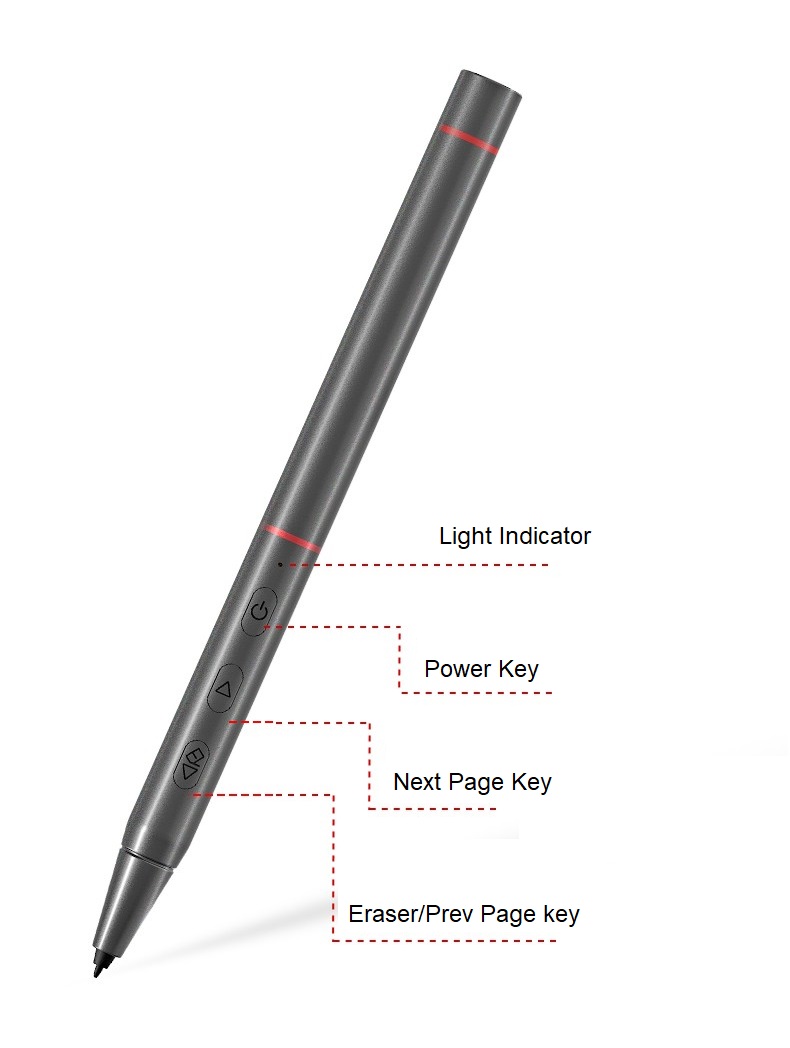Difference between revisions of "PineNote"
(Created new section and moved sections) |
(Creation of a new section) |
||
| Line 29: | Line 29: | ||
The device can be flashed using the following instructions: [[PineNote Development/Flashing]] | The device can be flashed using the following instructions: [[PineNote Development/Flashing]] | ||
== Development efforts == | |||
The following pages discuss the development efforts for the PineNote: | |||
* [[PineNote Development]] | |||
* [[PineNote Development/Flashing]] | |||
* [[PineNote Development/Booting Linux]] | |||
* [[PineNote Development/Building Kernel]] | |||
For app development see: | |||
* [[PineNote Development/Apps]] | |||
== Specification == | == Specification == | ||
Revision as of 19:03, 12 January 2023
The PineNote is the first hybrid notepad computer device combination of notebook, tablet and e-reader using an e-ink panel. It is derived from the Quartz64 model A SBC and powered by a Rockchip RK3566 quad-core ARM Cortex A55 64-bit processor with a MALI G-52 GPU.
Introduction
State of the software
The PineNote is based on the in 2021 released Rockchip RK3566 SoC. The upstreaming status of the SoC functionality can be found on the Quartz64 development wiki page of the Quartz64 single-board computer using the same SoC. In the PineNote development wiki page you'll find the items specific for the PineNote.
The early adopter's batch of the PineNote is aimed solely at early adopters - more specifically, the units are solely intended to find their way into the hands of users with extensive Linux experience. If you’re looking to buy a PineNote in the first batch, you must expect to write software for it, not to write notes on it. The software shipping from the factory for the first batch will not be suitable for taking notes, reading e-books, or writing your dissertation. It may not even boot to a graphical environment.
An early version of a GNOME-based Debian image is available for testing, but should not be expected to meet general-user readiness.
Help and support
Still have any questions regarding software, shipping, or ordering after reading this wiki? Please don't hesitate to contact the community in the bridged community channels for detailed answers or simply to chat with friendly people in the community! See Main Page#Community and Support.
Please keep in mind that PINE64 is not like a regular company (see the PINE64 philosophy) and that support resources are limited - the best way to get support quickly is to ask in the community chat! Please only contact the PINE64 support directly if questions couldn't be solved via the community chat or this wiki.
Software releases
There are no releases available at the current time.
Please join the development effort and help creating one.
Installation instructions
The device can be flashed using the following instructions: PineNote Development/Flashing
Development efforts
The following pages discuss the development efforts for the PineNote:
- PineNote Development
- PineNote Development/Flashing
- PineNote Development/Booting Linux
- PineNote Development/Building Kernel
For app development see:
Specification
General Information
- Dimensions: 191.1x232.5x7.4mm
- Weight: 438g
Core
- CPU: RK3566 1.8GHz 64-bit quad-core A55
- GPU: MALI G52 2EE
- System memory: 4GB LPDDR4
- Flash: 128GB eMMC
E-ink Display
- Size: 10.3"
- Resolution: 1404x1872
- DPI: 227
- Grayscale: 16
- Front Light: 36 level cold and warm
- Capacitive multi-touch panel
- EMR pen digitizer
Network
- WiFi: 2.4/5GHz 802.11a/b/g/n/ac
- Bluetooth: 5.0
Audio
- Built in stereo speakers
- 4 x DMIC microphone
Sensor
- G-Sensor for portrait and landscape sensing
Power
- 4000mAH LiPo battery
- DC 5V @ 3A USB-C connector
Accessories
- Optional EMR pen with magnetic attachment (included in the first production batch)
- Optional Cover (included in the first production batch)
SoC and Memory Specifications
- Based on Rockchip RK3566
CPU Architecture
- Quad-core ARM Cortex-A55@1.8GHz
- AArch32 for full backwards compatibility with ARMv7
- ARM Neon Advanced SIMD (single instruction, multiple data) support for accelerated media and signal processing computation
- Includes VFP hardware to support single and double-precision operations
- ARMv8 Cryptography Extensions
- Integrated 32KB L1 instruction cache and 32KB L1 data cache per core
- 512KB unified system L3 cache
- TrustZone technology support
- 22nm process, believed to be FD-SOI
GPU (Graphics Processing Unit) Capabilities
- Mali-G52 2EE Bifrost GPU@800MHz
- 4x Multi-Sampling Anti-Aliasing (MSAA) with minimal performance drop
- 128KB L2 Cache configurations
- Supports OpenGL ES 1.1, 2.0, and 3.2
- Supports Vulkan 1.0 and 1.1
- Supports OpenCL 2.0 Full Profile
- Supports 1600 Mpix/s fill rate when at 800MHz clock frequency
- Supports 38.4 GLOP/s when at 800MHz clock frequency
NPU (Neural Processing Unit) Capabilities
- Neural network acceleration engine with processing performance of up to 0.8 TOPS
- Supports integer 8 and integer 16 convolution operations
- Supports the following deep learning frameworks: TensorFlow, TF-lite, Pytorch, Caffe, ONNX, MXNet, Keras, Darknet
System Memory
- RAM Memory : 4GB LPDDR4.
- Flash Memory: 128GB eMMC
PineNote Information, Schematics, and Certifications
- PineNote Developer kit version
- The v1.2 is the PineNote production schematic.
- The v1.1 is early release schematic just for reference only and used by developers who received the prototype.
- Certifications:
Datasheets for Components and Peripherals
- Rockchip RK3566 SoC information:
- Rockchip RK817 PMU (Power Management Unit) Information:
- LPDDR4 (200 Balls) SDRAM:
- ---
- eMMC information:
- E-ink Panel information:
- Touch Screen information:
- Cypress CYTMA448 multi-Point Capacitive Touch Controller Datasheet
- Wacom Pen Digitizer Unit Model: SUDE-10S15MI-01X for 10.3" Display Module
- WiFi/BT module info:
- G Sensor info:
- Audio Amplifier information:
Development Efforts
- PineNote Development for general information regarding how to flash the device and other development information.
Software
- Quartz64 Development for the mainlining status of various functions on the Rockchip RK3566 SoC.
- RK3566 EBC Reverse-Engineering for the EBC (eInk Panel) driver.
Hardware
This section includes discussions and their results regarding hardware changes to the PineNote.
The following topics have resolved:
- PineNote/Hardware_Changes/Closed_Case_UART
- Could the USB-C port support USB 3.1 5Gbps? Yes and no. The RK3566 only has a host-mode 5Gbps controller, meaning it can only negotiate such a high data rate with a device such as a flash drive. When the RK3566 is acting as a device, it only supports 480Mbps transfer rates. The hardware required to switch between these modes would raise the PineNote's price unreasonably. Therefore, the USB-C port will remain at USB 2.0 speeds for Host and Device mode.
- Could the USB-C port output DisplayPort? Yes and no. The hardware required to support such a feature would raise the PineNote's price unreasonably. Therefore, DisplayPort output will not be possible through the USB-C port.
- Where is the microSD card slot? The case design of the PineNote is fixed, making physical changes like adding a microSD card slot would raise the cost unreasonably.
- How will I install software to the PineNote? This is a hardware and software question. If the software on your PineNote is completely broken and cannot boot to a recoverable state, a Hall (magnet) sensor was fitted to the PineTab motherboard as U9009. This sensor is attached to SARADC_VIN0_KEY/RECOVERY on the RK3566. With the device powered off, and screen face down, holding a magnet over U9009 and plugging in a USB-C cable causes the device to boot into "rockusb" flash mode. With proper flashing software and drivers, it should be possible to load a new operating system using rockusb if the system is soft-bricked. Of course, software vendors will need to be more careful with flashing firmware and providing useful "recovery" options on this device due to this process's relative difficulty to other PINE64 devices.
Unresolved
The following concerns have been brought up as open, unanswered topics:
- Does Audio Adapter Accessory Mode work? It appears that the Headphone output of the audio codec was routed to the USB-C audio+USB switch, but it's unclear whether CC lines are hooked up correctly for detection of such a device. The PineNote hardware team will be testing this functionality soon (as of August 19, 2021). Note that Audio Accessory mode is detectable by reading the I2C registers of the WUSB3801Q. So connecting ASEL to a GPIO would be enough to get this working if it is not working already.
- Why is the Headphone output of the audio codec routed to the speakers? HPL_OUT is routed from the RK817 PMIC and audio codec to U9010 (the USB-C switch) and U6 (the audio amplifier). SPK_OUT is unused. It seems like SPK_OUT should be routed to U6 and HPL_OUT to U9010.
- Nitpick: The cold white charging LED bleeds through the gap between the rear case and the device's face. It does not bleed onto the screen, but it is jarring in low-light conditions or when the screen is amber. Could be resolved in software by turning off the charge LED when the screen is on.
- Is there any way to indicate when the device is in rockusb mode, such as connecting a certain magic pin to the power LED?
- The modem/4G connector (J6010) has its I2C and UART pins unconnected. Could those be connected to the SoC?
USB-C Debug Accesory Mode (DAM)/UART Dongle
The USB UART dongle delivered with the PineNote allows you to have access to a serial port without having to open up the device. The factory firmware runs at a baud rate of 1500000bps, 8 data bits 1 stop bit, no parity and no flow control. The USB-C male end should go into the PineNote and the female end can be connected with a standard USB-C cable to your computer.
Documentation
PineNote development documentation is a little lacking. Unless you are relatively plugged in with the chat, it's difficult to know what is going on. There is an effort to amend that that lives here: PineNote Documentation.
BSP Linux SDK
BSP Linux SDK ver 4.19 for PineNote and Quart64 model A SBC
- Direct Download from pine64.org
- mirror by mwfc
- MD5 (TAR-GZip file): 24554419aec29700add97167a3a4c9ed
- File Size: 32.67.00GB
Android SDK
Android 11 eink SDK for PineNote and Quart64 model A SBC
- This is the Android SDK build for 10.3" eink panel on Quartz64 model A SBC.
- Direct Download from pine64.org
- mirror by mwfc
- MD5 (TAR-GZip file): 293a550584298de4fb95ceae18103672
- File Size: 72.88GB
- Just the boot blobs (<1MB): File:Rk35-blobs.tar.gz
- View Android SDK for RK3566 for more information how to compile an image for the PineNote using this SDK
Torrent
There is a torrent with the files (100GB)
Hardware troubleshooting guide
At present, nothing is available.


